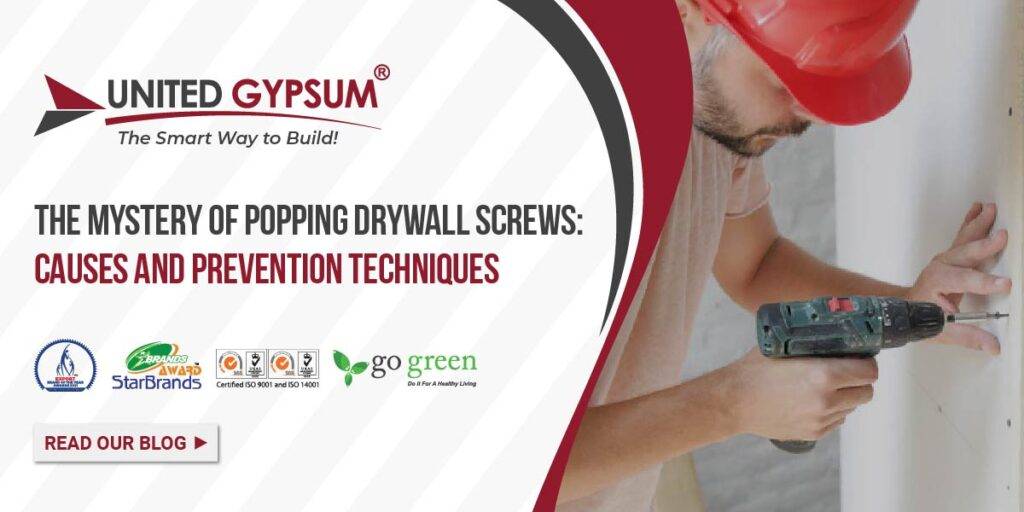For interior walls and ceilings, drywall is an increasingly popular choice since it’s cost-effective and simple to install. However, one frequent challenge that homeowners deal with is drywall screws that pop out. Homeowners may find it frustrating and unkempt when drywall screws start to come loose. Maintaining the integrity of the walls requires comprehending why this occurs alongside taking precautionary measures. We will examine the reasons behind drywall screw pop-outs in the next few paragraphs along with insightful guidance regarding ways to prevent this from happening.
Determining the Root Causes of Drywall Screw Pop-Outs
• Inadequate Methods of Installation
• Insufficient screw length: Screws that are disproportionately short may not offer sufficient grip, which could eventually result in pop-outs.
• Over-driving or under-driving screws: When driving screws into the drywall, exerting excessive force or insufficient effort will render the screws less secure.
• Improper positioning and spacing: Instability may result from screws that are not fastened to studs or that are positioned excessively apart.
Structural Movement
• Material expansion and contraction: Variations in temperature and moisture content can cause materials, such as gypsum boards, to expand and contract, compelling screws to move outward.
• Subfloor movement: When foundations are unstable or move about, pressure builds up on the wall surfaces, which can lead to the extrusion of screws.
• Residence settling: Over time, structural movement brought on by habitation can cause stress on the drywall and result in screw pops.
The Consequences of Popped-out Drywall Screws
Damage to Aesthetic Appeal
• Bulging Plasterboard: Popped screws can result in the plasterboard bulging, giving the surface an uneven and unpleasant appearance.
• Exposed screw heads: Unsightly protruding screw heads are a visual eyesore.
• Surface cracking: Screw pops may cause surface fractures in the drywall panels, further eroding the board’s visual appeal.
Inadequate Structural Integrity
• Weakened wall strength: Popped-out drywall screws diminish the structure’s ability to withstand weight, which could result in structural instability.
• Potential deterioration: If left unattended, loosened screws are capable of causing far greater issues, such as sagging or collapsing walls.
• Safety concerns: Loose screws may prove to be potentially hazardous, particularly around crowded locations as they might fall loose.
Important Guidelines for Repairing Popped Drywall Screws
Nuts and screws driven into the gypsum board could break free and pop out as a consequence of the shrinkage of the wooden studs underneath the plaster board or distortion of the wooden foundation. If you observe a quarter-sized lump on the wall’s surface or something like a screw head protruding from the wall, chances are you are dealing with a popping screw.
Assemble a battery-operated or manually operated screwdriver, drywall screws, putty knife, joint compound, fine sanding paper, and paint to patch up any bumps or cracks in the structure of the wall. Initially, attempt to push in the screw deeper with a screwdriver. One possibility is that a screw’s head has become loose from the body and continues to rotate without penetrating further into the material. In such a scenario, carefully pull out the screw head. Drive the second screw a of couple inches above the initial one, and the third one an inch or two down below, to alleviate most of the strain on the screw, irrespective of your decision to drive the screw in further or withdraw the screw head.
After filling up the gaps with the putty knife and drywall compound, allow them to cure for two to four hours at a time. Since the compound tends to sink in as it cures, sand off any excess and determine if you’ll need to apply additional layers. In that case, apply a second layer, allow it to cure, sand once more, and apply the paint coatings.
Strategies to Prevent Drywall Screw Pop-Outs
Making Use of the Correct Screw Length and Type
• Correct screw gauge and length: Make sure that the screws are sufficiently long to securely penetrate the studs with no damage.
• Picking screws designed specifically for drywall: To provide a firm grip while preventing a pop-out, choose screws with coarse threads and a bugle head.
Implementing Optimal Screw Positioning and Spacing
• Accurately identifying stud positions: To locate secure attachment sites, employ a stud finder or manual stud locating procedures.
• Appropriate screw spacing: To preserve stability throughout the gypsum board’s surface, adhere to standard guidelines for screw spacing.
Using the Correct Screw Driving Techniques
• Avoiding excessive or insufficient screw driving: Use a drilling tool or screwdriver with adjustable parameters to make sure screws are driven only deep enough to maintain a secure grip.
• Driving screws with even pressure: To prevent the screws from protruding out or driving in too deeply, apply consistent pressure.
Handling Structural Movement
• Limiting atmospheric moisture and temperature fluctuations: Maintain a stable interior environment by utilizing insulation or climate control measures to mitigate material expansion and contraction.
• Leveling subfloors before installing drywall: Take care of any potential issues concerning the foundation, ensuring that it is firmly fastened and does not put a disproportionate weight on the wall surfaces.
• Reinforcing structural joints and corners: Give particular consideration to these particularly susceptible places and reinforce them with appropriate corner beads and joint compound.
• Seeking expert help for structural repairs when necessary: To figure out and deal with the root causes of considerable structural movement or persistent screw pop concerns, consult an expert contractor or structural engineer for assistance.
The Bottom Line:
Drywall screw pop-outs are a nuisance for homeowners, but comprehending what causes them and complying with preventative strategies may save you time, money, and mental strain. You can preserve the integrity and appearance of the interior walls by using the right screws, employing correct installation procedures, and taking precautions to prevent any potential structural movement. Remember, prevention is key for steering clear of the hassle and financial burden associated with restoring popped drywall screws.

